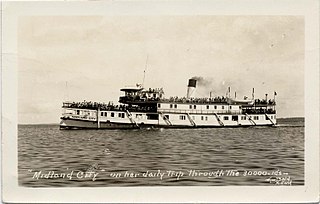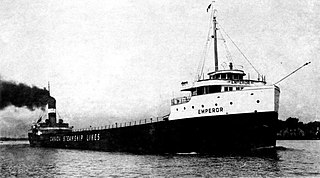
From its modern interpretations to its antecedents when maritime nations would send young naval officer candidates to sea, sail training provides an unconventional and effective way of building many useful skills on and off the water.

Moby Orli is a cruiseferry owned by Moby SPA. Until September 2010, she was known as Pride of Bilbao, operated by P&O Ferries on their Portsmouth–Bilbao route. The vessel was built in 1986 as Olympia at the Wärtsilä Perno Shipyard in Turku, Finland for Rederi AB Slite, Sweden for use in Viking Line traffic. She was sold by Irish Continental Group to St. Peter Line in December 2010 and renamed Princess Anastasia and operated on the Saint Petersburg – Helsinki – Stockholm – Tallinn route. In 2022 she was withdrawn because of the conflict in Ukraine, transferred to Moby Lines and sailed to Messina for refurbishment. She was set to return to service in the Mediterranean.
HMS Moira was a British 14-gun schooner of the Royal Navy, that plied the waters of Lake Ontario and the St. Lawrence River during the War of 1812. Initially constructed for the Provincial Marine in 1805, the vessel took part in the Engagements on Lake Ontario. Renamed Charwell in 1814, following the war, the vessel became a powder hulk and an accommodation vessel. The vessel was sold in 1837.

HMS Wolfe was a 20-gun sloop-of-war, launched at the Kingston Royal Naval Dockyard at Kingston, Upper Canada, on 22 April 1813. She served in the British naval squadron in several engagements on Lake Ontario during the War of 1812. Upon her launch, Wolfe was made the flagship of the squadron until larger vessels became available. Along with the naval engagements on Lake Ontario, Wolfe supported land operations in the Niagara region and at the Battle of Fort Oswego. Following the war, the vessel was laid up in reserve and eventually sold in 1832.
HMS Lord Melville was a brig of the Royal Navy launched at Kingston, Ontario, on 20 July 1813. Initially designed as a schooner, she was altered to 14-gun brig in 1813. She served on Lake Ontario during the War of 1812, and was renamed HMS Star on 22 January 1814. By 1815, she was unfit for anything but transport duties. She was sold in 1837.

The Marques was a British-registered barque that sank during the Tall Ships' Races in 1984.

Révolutionnaire, was a 40-gun Seine-class frigate of the French Navy, launched in May 1794. The British captured her in October 1794 and she went on to serve with the Royal Navy until she was broken up in 1822. During this service Revolutionnaire took part in numerous actions, including three for which the Admiralty would in 1847 award clasps to the Naval General Service Medal, and captured several privateers and merchant vessels.

Potosi was a five-masted steel barque built in 1865 by Joh. C. Tecklenborg ship yard in Geestemünde, Germany, for the sailing ship company F. Laeisz as a trading vessel. Its primary purpose was as a "nitrate clipper" collecting guano in South America for use in chemical companies in Germany. As its shipping route was between Germany, Bolivia until 1870 but, during the "pacific War" was transferred to Chile, it was designed to be capable of withstanding the rough weather encountered around Cape Horn.

HMS Recruit was an 18-gun Cruizer-class brig-sloop of the Royal Navy, launched in 1806 at Sandwich, Kent. She is best known for an act of pique by Commander Warwick Lake, who marooned a seaman, and for an inconclusive but hard-fought ship action under Commander Charles John Napier against the French corvette Diligente. She captured a number of American vessels as prizes during the War of 1812 before being laid up in 1815 and sold for breaking up in 1822.

SS Midland City was originally a Canadian side-wheel steamboat that provided passenger and cargo transportation on the Great Lakes from 1871 until 1955. Originally named Maud, then America, she underwent several extensive refits over her 84-year service, and saw several owners. The ship was intentionally run aground and burnt to the waterline in 1955 near the mouth of the Wye River in Midland Bay. The wreck is intact and visible above the water to this day, where it acts as a breakwater for the Wye Heritage Marina and local attraction.

Mohawk was a ship launched at Beverly, Massachusetts in 1781. She became a privateer, making two voyages. In 1782 the Royal Navy captured her and briefly took her into service under her existing name before selling her in 1783. She then became a merchantman until some investors in Bristol bought her in 1796 and turned her into a privateer again. In 1799 she became a letter of marque, but the French Navy captured her in 1801. She then served in the French Navy, capturing a British privateer in 1805, and was sold in 1814.

The George Spencer was a wooden lake freighter that sank on along with her schooner barge Amboy on Lake Superior, near Thomasville, Cook County, Minnesota in the Mataafa Storm of 1905. On April 14, 1994, the wrecks of the Spencer and the Amboy were listed on the National Register of Historic Places.
Enterprize was launched in France in 1797, probably under another name. The British captured her in 1803 and new owners sailed on four voyages as a slave ship. She twice recaptured British vessels, one a slave ship and one a merchant vessel, and once repelled an attack by a French privateer. Circa 1808 she left the slave trade and new owners sailed her to South America, where she was wrecked in 1810.
Hannah was built in Liverpool in 1795. She made four voyages as a slave ship in the triangular trade of enslaved people. She was lost in 1801 as she was returning home after having delivered her captives on her fourth voyage.
Windsor Castle was launched at Whitby in 1783. Initially she was primarily a West Indiaman. Then from 1797 she made five voyages as a slave ship in the triangular trade in enslaved people. She foundered off Bermuda in 1803 after having disembarked her captives.
Rosamond was launched at New York in 1771, probably as Rose. She was renamed Rosamond in 1776. Between 1795 and 1800 she made four voyages as a Liverpool-based slave ship, carrying enslaved people from West Africa to the West Indies. She then became a West Indiaman until in 1804 a French privateer captured her.
Friendship was launched in France or Spain, possibly in 1780. The British captured her in 1797 and she became a West Indiaman, and from 1798 a slave ship in the triangular trade in enslaved people. Friendship made two complete voyages carrying captives from West Africa to the West Indies. On her third voyage crew members mutinied, taking her before she had embarked any captives. They sailed for a French port in the Caribbean but the Royal Navy retook her in 1801 and brought her into Barbados. There the Government Agent sold her. The incident resulted in a legal dispute between the owners and the insurers that in 1813 was decided in favour of the owners. New owners in 1803 continued to sail Friendship as West Indiaman. She was last listed in 1810.

SS Emperor was a steel-hulled Canadian lake freighter in service between 1911 and 1947. She was built between 1910 and April 1911 by the Collingwood Shipbuilding Company in Collingwood, Ontario, for Inland Lines, Ltd., of Midland, Ontario. She entered service on May 3, 1911. Emperor was sold to Canada Steamship Lines of Montreal, Quebec. Under the ownership of Canada Steamship Lines, she carried a wide variety of cargoes, but most frequently iron ore to Point Edward, Ontario, where it would be transported to Hamilton, Ontario, by train. After the opening of the fourth Welland Canal, Emperor carried the ore directly to Hamilton. She was involved in several accidents throughout her career.
Beaver was launched in 1796 at Liverpool. She made seven complete voyages as a slave ship in the triangular trade in enslaved persons. She was captured and retaken once, in 1804, and captured a second time in 1807, during her eighth voyage.
King Grey, first appeared in online British records in 1786. She made five enslaving voyages between 1786 and 1793. On her last enslaving voyage the French captured her but the Royal Navy quickly recaptured her. She was sold at Kingston, Jamaica. She became a privateer but in December 1795 fire from French Republican shore artillery sank her at Tiburon where she was supporting French Royalist forces as an armed ship.












